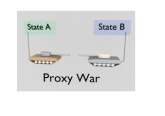This month, which sees the centenary anniversary of the outbreak of World War I, is a time of reflection and remembrance for Europe. It is therefore an appropriate time for Politics in Spires to review Professor MacMillan’s recent book on this origins of the First World War, The War that Ended Peace. Below is an interview with Margaret Macmillan and a review by her interviewer, Katharine Brooks.
The War that Ended Peace can truly be termed a masterful work of scholarship, detailing the origins of the war in both outstanding breadth and depth. The book does not tell a new story of the origins of World War I, but it does tell a more intimate one. Macmillan manages to synthesise a consideration of the environmental and structural factors in the years before 1914 with a sympathetic and engaging examination of the particular motivations and characters of the men who took Europe to war in 1914.
The book is ordered in three parts; the first explaining the diplomatic alignment of Europe during the years preceding the outbreak of war; the second focusing the prevailing cultural and ideological milieu in the early years of the twentieth century; and the third detailing the successive crises in the years immediately preceding the outbreak of war. In this way, MacMillan takes the reader through a logical and persuasive account of the outbreak of the war – providing you with an understanding of how both the alliance system and prevailing ideologies interacted with the events leading up to the outbreak of the war in such a way as to make seemingly unintelligible developments comprehensible.
In the first part of the book, Macmillan details the progressive construction and ossification of the alliance system and how “what seemed defensive from one perspective was a threat from another” (p. 503). In doing so, she covers well-trodden ground. The role of the Anglo-German naval race in fostering continental hostilities has long been an accepted part of the narrative of the origins of World War I. However, the manner in which it is dealt with by MacMillan, who details the precise motivations, biases and prejudices of those involved – particularly the respective architects of the naval race – entails that she manages to shed new light on this theme.
As identified within the interview, Macmillan does not attempt to disguise the extent to which she believes history is often made by individuals, arguing that “there were those individual, especially Wilhelm himself and Bethmann, who had the power to decide between war and peace and who in the end were persuaded that war was the better option” (p. 523). She therefore pays great attention to understanding the decision-making processes of the individuals concerned. Within Macmillan’s narrative, the personal elements of misunderstandings and miscommunications help to elucidate why the leaders of that time failed, so woefully, to misunderstand one another. It tells the intricate story of misperception and growing hostility between the European countries prior to the outbreak of the war, and of the Kaiser’s particular role in fostering these.
Moreover, she brings her history to life with the addition of amusing personal anecdotes. My particular favourite was that about Henry Wilson, Director of Military Operations after 1910; a man reputed to bear a strong resemblance to a gargoyle. She notes that “someone once addressed a postcard to the ugliest man in the British army and it reached him without difficulty.”
Another strength of the book is that, unlike most histories of the origins of the war, it writes the history of women of the time. Macmillan notes the roles of the wives, mothers, and sisters of the various decision makers at the time, their influence upon them, and thus upon the decisions eventually made.
In the second part of the book, Macmillan provides an overview of the cultural and ideological context of the early twentieth century – in particular, those ideas that made war appear to many a feasible, if not desirable, option. In doing so, Macmillan pays specific attention to the role of concepts such as honour and masculinity and the overarching interaction between these archaic codes of behaviour and the social changes occurring at that time: “As Europe went through its rapid social changes in the last part of the nineteenth century, honour became both an attribute that the old landowning classes could cling to with increasing determination as something that distinguished them from the newly prosperous middle classes and, for the socially ambitious, a mark of a higher and better social status.” (p. 234).
Later in the book, MacMillan provides examples of how this overarching culture of honour influenced the actions of leaders in those fateful weeks in July: “The Kaiser was now under great pressure to declare a general mobilization from his generals who saw time slipping away and from his own wife who told him to be a man” (p. 576-577). “Bethmann used what was perhaps the most revealing phrase of all when he said that for Germany to back down in the face of its enemies would be an act of self-castration” (p. 529).
The rising tide of eugenics and the concomitant glorification of war as a means of purifying the races was also influential in creating a permissive environment for conflict to occur: “with such attitudes, war often seemed desirable, both as the honourable way to struggle against fate and as a way of reinvigorating society” (p. 246).
In this, second, part of the book, Macmillan also pays heed to other factors that pertained to the maintenance of structures that, in the end, helped push Europe into war; such as the nature and policies of military command in the major European countries. In particular, it is clear that the German military perceived itself largely as an autonomous actor and acted accordingly. The German military also appeared to work in a vacuum. For example, according to Macmillan, the German military planned the invasion of France through Belgium without really considering the political implications of such a move. Later, in the aftermath of the assassination of Archduke Franz-Ferdinand, the German military and its government sent contradictory messages to Austria-Hungary; with the Kaiser and Bethmann pressing for Austria-Hungary to resort to international mediation while Moltke, Chief of the German General Staff, urged speed of mobilization, promising Germany’s support. This, unsurprisingly, created chaos in Austria-Hungary where the leaders were forced to choose which advice to follow and, in the end, chose Moltke’s.
Macmillan contests, however, the oft-made charge that “the rigidity of the pre-war plans created doomsday machines that once set in motion could not have been stopped,” arguing that “complex as they were, railway and mobilization schedules could be and indeed were altered in their details every year” (p. 301). She instead suggests “what the plans did do to bring about the Great War was put additional pressure on the decision-makers by shortening the time in which decisions had to be taken.”
In the third part of the book, Macmillan relates in detail the various crises, notably over Morocco in the Balkans in the years preceding 1914. It was in the Balkans, however, that “the greatest dangers were to arise: two wars among its nations, one in 1912 and a second in 1913, nearly pulled the great powers in” (p. 436). According to Macmillan, “what made the Balkans so dangerous was that a highly volatile situation on the ground mingled with great power interests and ambitions” (p.446). The years prior to 1914 are painted as a period of intense suspicion among the powers where small errors frequently led to discussions of the possibility of conflict and where the fabric holding Europe together began to fray.
Despite the forces pressing for war during these earlier crises, Europe nonetheless always found a way to pull back from the brink at the last minute. However, it was precisely “Europe’s very success in surviving those earlier crises [that] paradoxically led to a dangerous complacency in the summer of 1914” that, yet again, solutions would be found at the last moment and the peace would be maintained. This, to a large extent, explains why so many leaders were slow to react to developing events before it was too late: “Jaures, the great French socialist, put his finger on it; ‘Europe has been afflicted by so many crises for so many years, it has been put dangerously to the test so many times without war breaking out that it has almost ceased to believe in the threat and is watching the further development of the interminable Balkan conflict with decreased attention and reduced disquiet” (p. 510).
Macmillan’s narrative contests, throughout, many of the more fatalistic explanations of the war. Her very title alludes to her belief that the fact that the peace failed is in itself worthy of explanation. In the end, her narrative is useful not only for historians of the topic but also policymakers who should beware the error of allowing seemingly inevitable events to occur that they were, in fact, able to prevent. As she concludes:“And if we want to point fingers from the twenty-first century we can accuse those who took Europe into war of two things. First, a failure of imagination in not seeing how destructive such a conflict would be and second, their lack of courage to stand up to those who said that there was no choice left but to go to war. There are always choices.” (p. 605)







No Comment